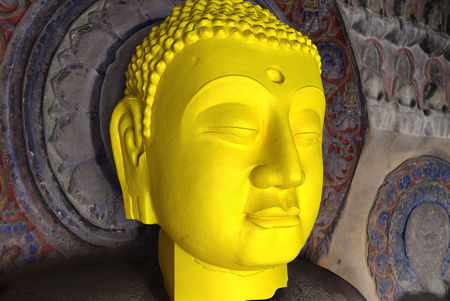The Buddhist Cave Temples of Xiangtangshan @ Smart Museum of Art
Xiangtangshan, Head of a Bodhisattva (Attendant of Maitreya), mid sixth century, Limestone with traces of pigment. University of Pennsylvania Museum of Archaeology and Anthropology, Purchased from C. T. Loo, with funds from James B. Ford, 1918, C354. Photography by John Tsantes.
CHICAGO, IL.- The University of Chicago’s Smart Museum of Art and the Smithsonian Institution’s Arthur M. Sackler Gallery present Echoes of the Past: The Buddhist Cave Temples of Xiangtangshan, a major new traveling exhibition that traces the historical origins, tragic despoliation, and digital reconstruction of one of the most important groups of Buddhist devotional sites in early medieval China. Drawing on a multi-year research and 3-D imaging project based at the Center for the Art of East Asia at the University of Chicago, the exhibition mixes ancient objects from Xiangtangshan—considered among the finest achievements of Chinese sculpture—with innovative digital components, including a video installation that provides an immersive, kinetic re-creation of one of the largest stone temples.
Carved into the mountains of northern China, the Buddhist cave temples of Xiangtangshan (, pronounced “shahng-tahng-shahn”) were the crowning cultural achievement of the sixth-century Northern Qi dynasty. Once home to a magnificent array of sculptures—monumental Buddhas, elaborate attendant figures, and crouching monsters framed by floral motifs—the limestone caves were severely damaged in the first half of the twentieth century when their contents were chiseled away and offered for sale on the international art market. After years of intensive research, it is now possible to digitally envision much of the caves’ initial appearance. Echoes of the Past provides new insight into Xiangtangshan’s original designs and meanings while offering a new approach to understanding and interpreting damaged cultural sites.
The Xiangtangshan caves were created during the Northern Qi dynasty (550–577 CE), a brief but significant period of cultural and artistic innovation in Chinese history. Translated as “Mountain of Echoing Halls,” the name Xiangtangshan refers to a total of 11 caves spread among three distinct sites in Hebei province. Planned and executed on a grand scale through imperial patronage, the largest of the caves was approximately 40 feet in height and over 800 square feet in area. Aided by the relative isolation of the caves, Xiangtangshan was not “discovered” until early in the twentieth century. Large-scale despoliation began in 1910 and continued for decades, as free-standing figures and other key sculptural elements were removed from the site. These fragments began to appear in public and private art collections outside of China, sold on a burgeoning antiquities market to dealers, collectors, and museums around the globe.
Because Xiangtangshan was damaged so extensively, it has been all but impossible for recent observers to appreciate the original appearance of the caves, or to understand the rich and complex artistic achievement they once represented. In 2004, the University of Chicago’s Center for the Art of East Asia launched a project to identify, locate, research, and document the dispersed stone carvings of the Xiangtangshan caves. Using sophisticated threedimensional scanning equipment, the project’s imaging team has photographed and scanned nearly 100 objects believed to be from Xiangtangshan, which are now located in museums and private collections across the United States, Canada, Europe, Australia, Japan, and Taiwan. Through a collaboration with Peking University and the Fengfeng Office for the Protection and Management of Cultural Properties, the imaging team was also granted official permission to photograph and scan the Xiangtangshan cave sites.
The Smart Museum’s presentation of Echoes of the Past includes 13 objects from Xiangtangshan and three related Northern Qi works of art. The exhibition juxtaposes dispersed sculptural fragments with a set of media projects including an immersive video installation, a brief documentary film about the present-day environs of the cave sites, and interactive touchscreen labels related to the monumental stone fragments on view. The “digital cave” video installation, overseen by media artist Jason Salavon, is a centerpiece of the exhibition, and provides an immersive, kinetic re-creation of one of the largest temples through a sequenced montage of archival photographs and contemporary 3-D images that trace an arc of despoliation, preservation, and reconstruction. A contemporary view of Northern Xiangtangshan, South Cave
The Xiangtangshan sculptures on view at the Smart Museum are on loan from the Asian Museum of San Francisco, the Cleveland Museum of Art, the Sackler Collections at Columbia University, the Metropolitan Museum of Art, the University of Pennsylvania Museum of Archaeology and Anthropology, the Victoria and Albert Museum, and the Virginia Museum of Fine Arts. As the exhibition tours, it will be supplemented by additional loans, and select venues will incorporate objects from their own permanent collections.
Seated Buddha accompanied by six standing attendant deities, east wall altar, South Cave, Northern Xiangtangshan. Photography by Dan Downing
-D digital reconstruction from east wall altar, South Cave, Northern Xiangtangshan, with missing fragments shown in yellow. Image by Jason Salavon and Travis Saul.

/https%3A%2F%2Fprofilepics.canalblog.com%2Fprofilepics%2F1%2F0%2F100183.jpg)
/https%3A%2F%2Fstorage.canalblog.com%2F03%2F02%2F119589%2F96711876_o.jpg)
/https%3A%2F%2Fstorage.canalblog.com%2F11%2F31%2F119589%2F94773502_o.jpg)
/https%3A%2F%2Fstorage.canalblog.com%2F20%2F83%2F119589%2F94772815_o.jpg)
/https%3A%2F%2Fstorage.canalblog.com%2F26%2F72%2F119589%2F75604929_o.jpg)
/https%3A%2F%2Fstorage.canalblog.com%2F59%2F60%2F119589%2F26458628_o.jpg)





/http%3A%2F%2Fstorage.canalblog.com%2F66%2F57%2F119589%2F128006789_o.jpg)
/http%3A%2F%2Fstorage.canalblog.com%2F62%2F28%2F119589%2F33849192_o.jpg)
/http%3A%2F%2Fstorage.canalblog.com%2F51%2F21%2F119589%2F31627637_o.jpg)
/http%3A%2F%2Fstorage.canalblog.com%2F14%2F62%2F119589%2F30233525_o.jpg)